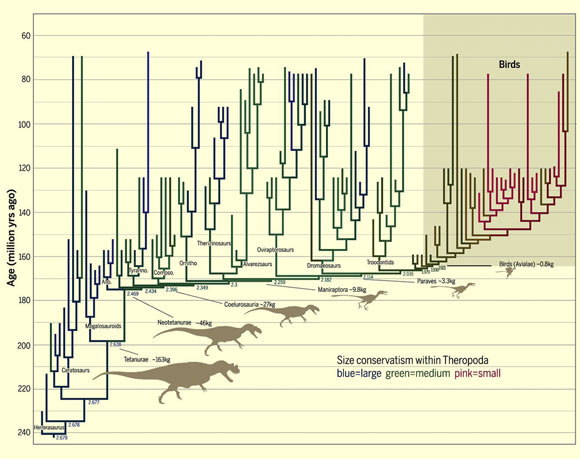A new study published in the journal Science highlights the dramatic evolutionary transformation of carnivorous, ground-dwelling theropod dinosaurs into flying birds.

The dinosaur lineage that evolved into birds shrank in body size continuously for 50 million years. Image credit: Michael S. Y. Lee et al. Science, 10.1126/science.1252243.
“Birds out-shrank and out-evolved their dinosaurian ancestors, surviving where their larger, less evolvable relatives could not,” said study lead author Dr Michael Lee of the University of Adelaide and South Australian Museum.
Dr Darren Naish of the University of Southampton, UK, a co-author on the study, added: “these bird ancestors also evolved new adaptations, such as feathers, wishbones and wings, four times faster than other dinosaurs.”
Dr Lee, Dr Naish and their colleagues examined 1,549 anatomical traits of dinosaurs to reconstruct their detailed family tree. It shows that the miniaturization of theropod dinosaurs started about 50 million years before the earliest known birds lived.
“The dinosaurs most closely related to birds are all small, and many of them – such as Microraptor – had some ability to climb and glide,” said senior author Dr Gareth Dyke of the University of Southampton.
“Birds evolved through a unique phase of sustained miniaturization in dinosaurs. Being smaller and lighter in the land of giants, with rapidly evolving anatomical adaptations, provided these bird ancestors with new ecological opportunities, such as the ability to climb trees, glide and fly,” Dr Lee said.
“Ultimately, this evolutionary flexibility helped birds survive the meteorite impact which killed off all their dinosaurian cousins.”
_____
Michael S. Y. Lee et al. 2014. Sustained miniaturization and anatomical innovation in the dinosaurian ancestors of birds. Science, vol. 345, no. 6196, pp. 562-566; doi: 10.1126/science.1252243







